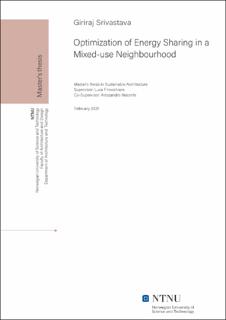| dc.contributor.advisor | Finocchiaro, Luca | |
| dc.contributor.advisor | Nocente, Alessandro | |
| dc.contributor.author | Srivastava, Giriraj | |
| dc.date.accessioned | 2021-12-02T18:20:08Z | |
| dc.date.available | 2021-12-02T18:20:08Z | |
| dc.date.issued | 2021 | |
| dc.identifier | no.ntnu:inspera:67885852:34741080 | |
| dc.identifier.uri | https://hdl.handle.net/11250/2832648 | |
| dc.description.abstract | Peak load shaving og energifleksibilitet i moderne nabolag kan redusere klimagassutslippene, nettkapasitet og energipris i stor grad. Likevel er det gjort lite forskning rundt optimalisering av peak load shaving og energifleksibilitet i urban planlegging. Denne masteroppgaven undersøker muligheter for energideling i et hypotetisk nabolag for å maksimere peak load shaving and minimere netto energiforbruk. Oppgaven viser en metodikk for å beregne og analysere energibehovet og produksjonen for hver time på årlig basis for forskjellige bygningstyper og bruttoarealer. Netto energiforbruk og peak load shaving er optimalisert, først individuelt, og deretter sammen via kvalitativ analyse av begge parameter. OEN bygningen i Ammerud, Oslo er brukt som case-studie. En sydvendt seksjon av bygningen ble forenklet til en polygonform og ble brukt for å simulere energibehovet av boliger, kontorer og butikklokaler bygningstyper. Masteroppgaven viser at både netto energiforbruk og peak load shaving er omvendt proporsjonal med areal av bygningstypen med laveste netto energiforbruk. Det betyr at nabolags netto energiforbruk reduseres med økning i arealet av bygningstypen med laveste netto energiforbruk, og nabolagsmulighet for peak load shaving øker med økning i arealet av bygningstypen med høyeste netto energiforbruk. Formålet med oppgaven var å minimere netto energiforbruk og maksimere peak load shaving samtidig. Det er observert at man må gå på kompromiss for å gjøre dette. Resultatet viser at et nabolag med 10% boliger, 40% kontorer, og 50% butikklokaler er det mest optimale. Metodikken foreslått i denne oppgaven kan bli brukt for å optimalisere områdefordelingen av forskjellige bygningstyper i nabolagsplaner for å redusere netto energiforbruk og øke peak load shaving. | |
| dc.description.abstract | Peak load shaving and energy flexibility of modern neighbourhoods show a great potential to reduce GHG emissions, grid capacity, and energy prices. However, research on planning of urban neighbourhoods to optimize these criteria are very limited. This study investigates the energy sharing potential of a hypothetical neighbourhood to maximize the PLS and minimize the NEC, by proposing a methodology to calculate and analyse the hourly energy consumption and production of different building typologies with varying built-up area. The optimization of NEC and PLS are carried out individually through single parameter optimization
and then a qualitative scale is used for multi-objective optimization of both, NEC and PLS with both given equal importance. A south-facing section of the OEN building proposed model is simplified into a polygon form and used as a base model to simulate residential, office and retail typologies. The study demonstrates that both, neighbourhood NEC and PLS potential are inversely proportional to the area of the typology with minimum NEC. That is, the NEC of neighbourhood decreases with increase in area of typology with minimum NEC, and PLS potential of neighbourhood increases with increase in area of typology with maximum NEC. As the goal of the study is to minimize the neighbourhood NEC and maximize the PLS, it is observed that a well-informed compromise has to be made. The multi-objective optimization results show that a neighbourhood with 10% residential, 40% office and 50% retail is the optimum compromise. The methodology proposed in the study can be used for planning phase of neighbourhoods to optimize the program area distribution in order to reduce NEC and increase the PLS of the neighbourhood. | |
| dc.language | eng | |
| dc.publisher | NTNU | |
| dc.title | Optimization of Energy Sharing in a Mixed-use Neighbourhood | |
| dc.type | Master thesis | |
